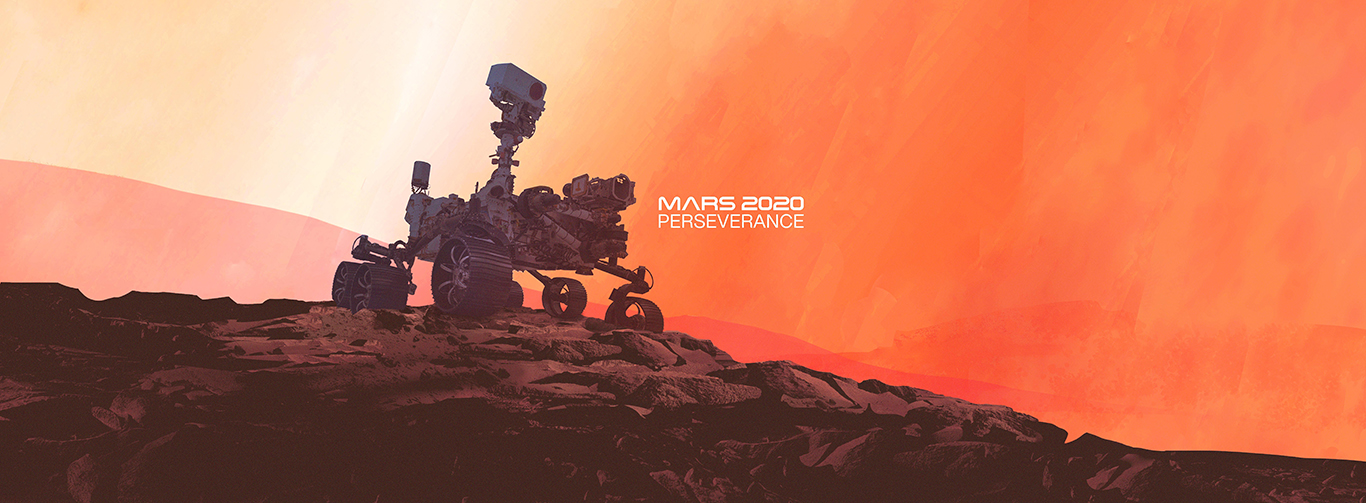
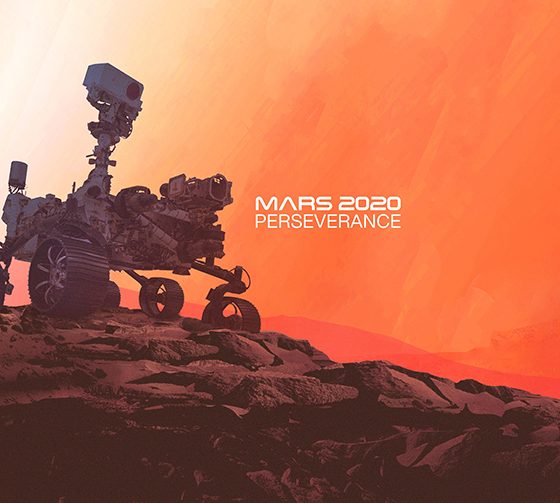
News
NASA set for upcoming Mars mission to seek signs of ancient life on the red planet
Just three weeks ahead of liftoff, NASA and launch provider United Launch Alliance (ULA) announced that NASA’s Mars 2020 rover, Perseverance, and its Martian helicopter sidekick, Ingenuity, were mated with the Atlas V 541 rocket that will kick off the seven-month journey to the Red Planet. The precious cargo encapsulated inside of a protective payload fairing was carefully hoisted by crane operators to rest atop the Atlas V rocket. The payload joins the Atlas V common core booster, four solid rocket boosters, and the Centaur upper stage to achieve the stack’s final flight configuration height of 197 feet (60 meters).
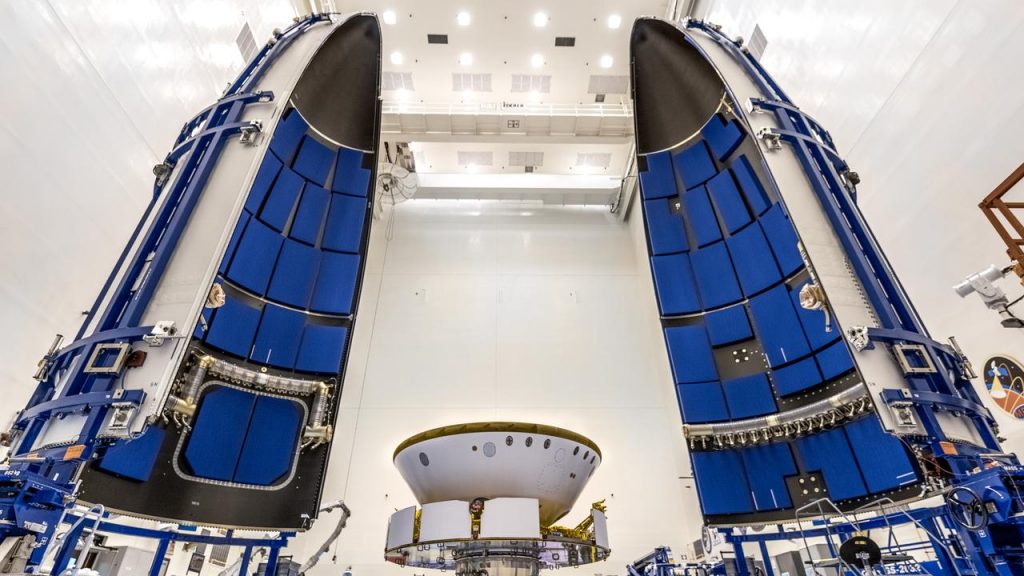
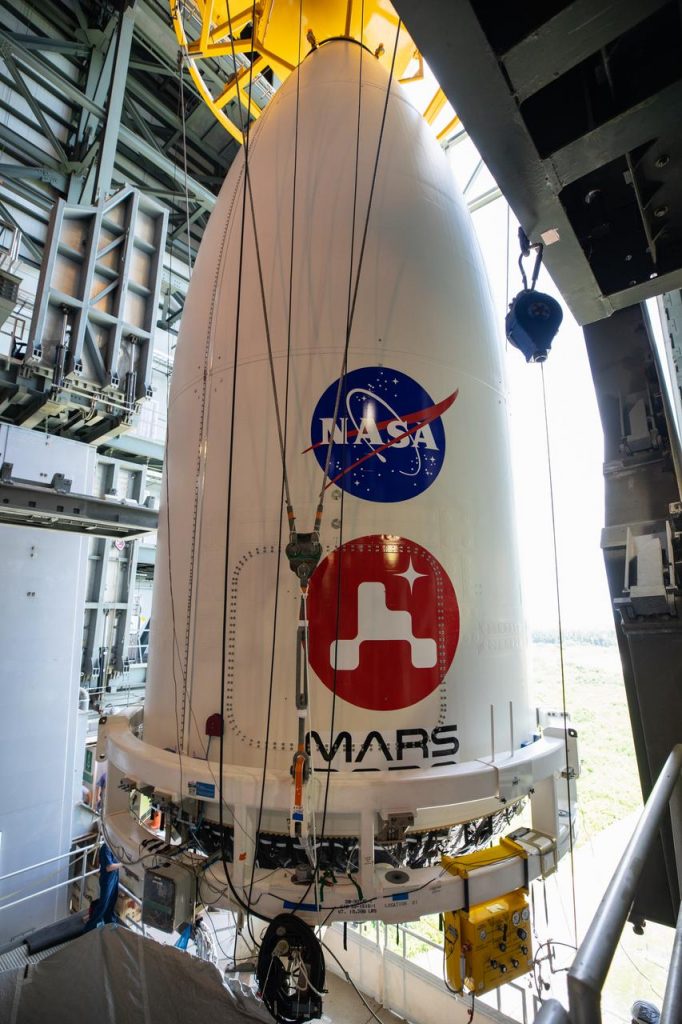
The United Launch Alliance (ULA) payload fairing with NASA’s Mars 2020 Perseverance rover secured inside is positioned on top of the ULA Atlas V rocket inside the Vertical Integration Facility (VIF) at Space Launch Complex 41 at Cape Canaveral Air Force Station in Florida on July 7, 2020. (Image Credit: NASA/Kim Shiflett)
The final stacking procedure was completed inside of the Vertical Integration Facility (VIF) at Cape Canaveral Air Force Station’s Space Launch Complex 41 (SLC-41). The rocket and payload will remain inside the protective structure and complete final check out tests until it is time quite literally roll to the launchpad. Crane operators first set down the payload for a soft touch to begin final full physical and electrical connection. The spacecraft and rocket will undergo integrated electrical testing as well as a battery of other tests as separate spacecraft and simultaneously as one complete unit.
On Friday (July 10), ULA president and chief executive officer, Tory Bruno, stated on Twitter that the Integrated Systems Test (IST) had been completed successfully. According to a previous mission statement posted to the ULA blog site, the IST is a typical pre-launch run down of the various connected systems between the spacecraft and launch vehicle to “verify proper functionality of launch vehicle systems, (and) conduct a simulated countdown and run through the launch sequence.”
The launch vehicle and integrated payload will remain inside the VIF undergoing mission-specific activities and final system checkouts over the next two weeks. Once all pre-flight activities have been successfully completed, approximately two days ahead of the scheduled launch attempt, the entire stack located on top of the Mobile Launch Platform will make the 1,800ft (550 meters) trip to the SLC-41 launchpad which will take about forty-minutes on a modified railway.
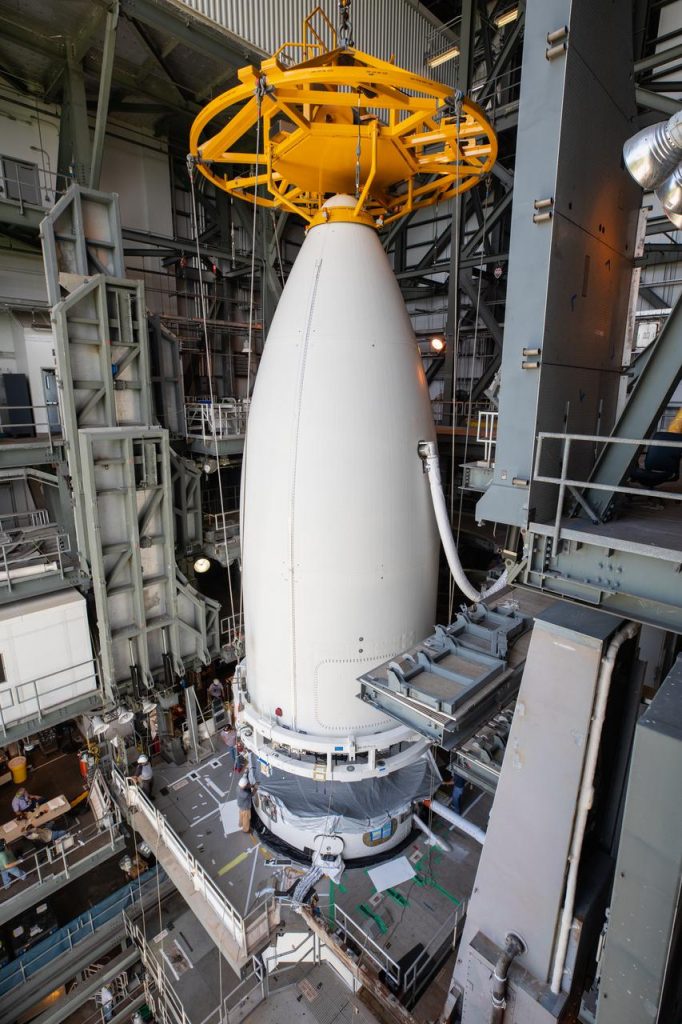
Known as an astrobiology mission and outfitted with seven instruments, the Perseverance rover will conduct new science, sample collection, and test new technology in search of ancient microbial life on the distant planet. The rover will spend the length of one Martian year – two Earth years – exploring the region around its landing site. It will collect and cache samples of the Martian surface to possibly be collected and returned to Earth by future joint missions currently under consideration by NASA and the European Space Agency.

The first interplanetary helicopter, Ingenuity, is a small 4-pound (1.8 kilograms) autonomous solar-powered aircraft that will conduct a series of experimental test flights. Ingenuity is traveling to Mars solely for a demonstrative mission and is not connected to the Perseverance rover by any means other than hitching a ride to the Red Planet. The new technology will demonstrate an ability to create lift in the thin atmosphere and lower gravity environment of Mars to help inform future aerial exploration and science delivery missions.
Currently, NASA and ULA are targeting the launch of the interplanetary mission on July 30th at 7:50 am EDT/4:50 PDT. Should they be necessary, multiple backup launch opportunities are available until the close of the interplanetary launch window on August 15th. Regardless of the launch date, after a seven-month-long, 290 million mile (467 million kilometers) journey – the rover and helicopter will arrive at Mars’s Jezero Crater, the home to an ancient Martian river delta, for a landing attempt on February 18, 2021. The landing date is perhaps even more crucial than the launch date as mission planners must take into account landing site lighting and temperature conditions and the locations of Mars-orbiting satellites required to relay crucial mission-specific information back to Earth.
Should the launch have to abort, and the 2020 window is missed completely, the robots will have to wait until 2022 when Earth’s orbit lines up just right with that of Mars, and the next interplanetary launch window opens up.

News
Tesla adds new feature that will be great for crowded parking situations
This is the most recent iteration of the app and was priming owners for the slowly-released Holiday Update.
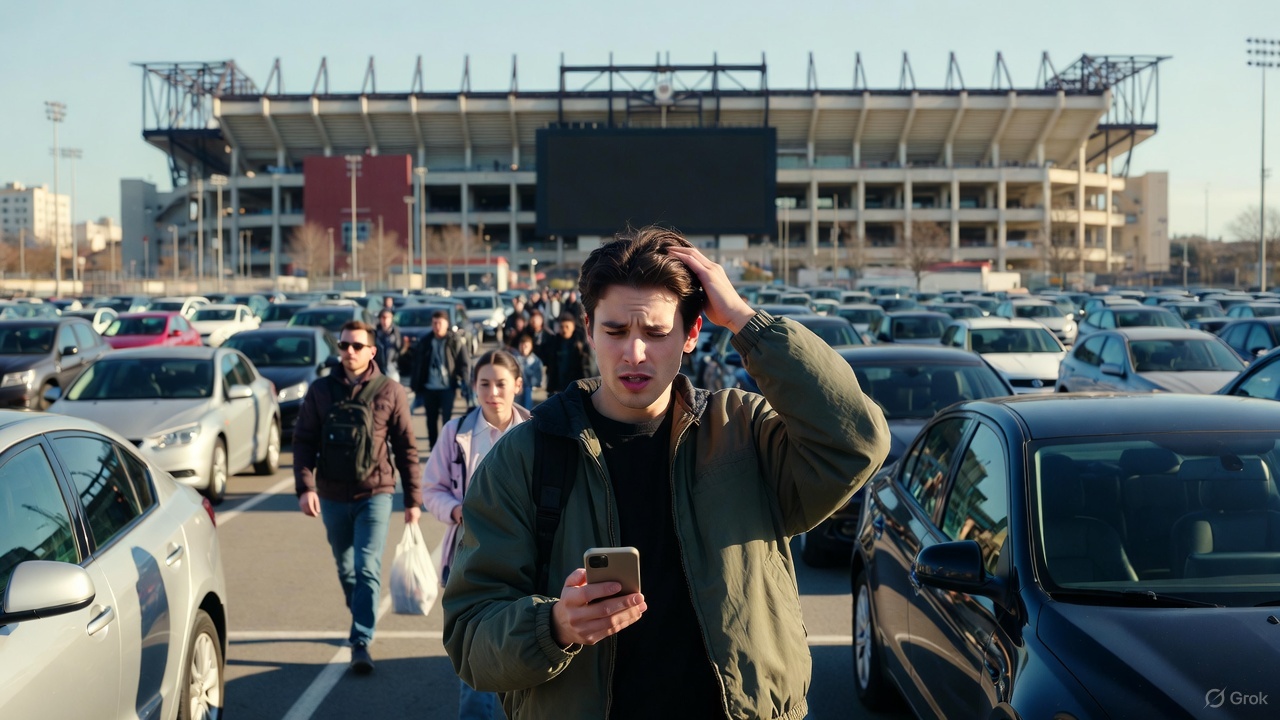
Tesla has added a new feature that will be great for crowded parking lots, congested parking garages, or other confusing times when you cannot seem to pinpoint where your car went.
Tesla has added a new Vehicle Locator feature to the Tesla App with App Update v4.51.5.
This is the most recent iteration of the app and was priming owners for the slowly-released Holiday Update.
While there are several new features, which we will reveal later in this article, perhaps one of the coolest is that of the Vehicle Locator, which will now point you in the direction of your car using a directional arrow on the home screen. This is similar to what Apple uses to find devices:
Interesting. The location arrow in the Tesla app now points to your car when you’re nearby. pic.twitter.com/b0yjmwwzxN
— Whole Mars Catalog (@wholemars) December 7, 2025
In real time, the arrow gives an accurate depiction of which direction you should walk in to find your car. This seems extremely helpful in large parking lots or unfamiliar shopping centers.
Getting to your car after a sporting event is an event all in itself; this feature will undoubtedly help with it:
The nice little touch that Tesla have put in the app – continuous tracking of your vehicle location relative to you.
There’s people reporting dizziness testing this.
To those I say… try spinning your phone instead. 😉 pic.twitter.com/BAYmJ3mzzD
— Some UK Tesla Guy (UnSupervised…) (@SomeUKTeslaGuy) December 8, 2025
Tesla’s previous app versions revealed the address at which you could locate your car, which was great if you parked on the street in a city setting. It was also possible to use the map within the app to locate your car.
However, this new feature gives a more definitive location for your car and helps with the navigation to it, instead of potentially walking randomly.
It also reveals the distance you are from your car, which is a big plus.
Along with this new addition, Tesla added Photobooth features, Dog Mode Live Activity, Custom Wraps and Tints for Colorizer, and Dashcam Clip details.
🚨 Tesla App v4.51.5 looks to be preparing for the Holiday Update pic.twitter.com/ztts8poV82
— TESLARATI (@Teslarati) December 8, 2025
All in all, this App update was pretty robust.
Elon Musk
Tesla CEO Elon Musk shades Waymo: ‘Never really had a chance’

Tesla CEO Elon Musk shaded Waymo in a post on X on Wednesday, stating the company “never really had a chance” and that it “will be obvious in hindsight.”
Tesla and Waymo are the two primary contributors to the self-driving efforts in the United States, with both operating driverless ride-hailing services in the country. Tesla does have a Safety Monitor present in its vehicles in Austin, Texas, and someone in the driver’s seat in its Bay Area operation.
Musk says the Austin operation will be completely void of any Safety Monitors by the end of the year.
🚨 Tesla vs. Waymo Geofence in Austin https://t.co/A6ffPtp5xv pic.twitter.com/mrnL0YNSn4
— TESLARATI (@Teslarati) December 10, 2025
With the two companies being the main members of the driverless movement in the U.S., there is certainly a rivalry. The two have sparred back and forth with their geofences, or service areas, in both Austin and the Bay Area.
While that is a metric for comparison now, ultimately, it will not matter in the coming years, as the two companies will likely operate in a similar fashion.
Waymo has geared its business toward larger cities, and Tesla has said that its self-driving efforts will expand to every single one of its vehicles in any location globally. This is where the true difference between the two lies, along with the fact that Tesla uses its own vehicles, while Waymo has several models in its lineup from different manufacturers.
The two also have different ideas on how to solve self-driving, as Tesla uses a vision-only approach. Waymo relies on several things, including LiDAR, which Musk once called “a fool’s errand.”
This is where Tesla sets itself apart from the competition, and Musk highlighted the company’s position against Waymo.
Jeff Dean, the Chief Scientist for Google DeepMind, said on X:
“I don’t think Tesla has anywhere near the volume of rider-only autonomous miles that Waymo has (96M for Waymo, as of today). The safety data is quite compelling for Waymo, as well.”
Musk replied:
“Waymo never really had a chance against Tesla. This will be obvious in hindsight.”
Waymo never really had a chance against Tesla. This will be obvious in hindsight.
— Elon Musk (@elonmusk) December 10, 2025
Tesla stands to have a much larger fleet of vehicles in the coming years if it chooses to activate Robotaxi services with all passenger vehicles. A simple Over-the-Air update will activate this capability, while Waymo would likely be confined to the vehicles it commissions as Robotaxis.
News
Tesla supplier Samsung preps for AI5 production with latest move
According to a new report from Sedaily, Samsung is accelerating its preparation for U.S. production of the AI5 chips by hiring veteran engineers for its Customer Engineering team.

Tesla supplier Samsung is preparing to manufacture the AI5 chip, which will launch the company’s self-driving efforts even further, with its latest move.
According to a new report from Sedaily, Samsung is accelerating its preparation for U.S. production of the AI5 chips by hiring veteran engineers for its Customer Engineering team, which will help resolve complex foundry challenges, stabilize production and yields, and ensure manufacturing goes smoothly for the new project.
The hiring push signals that Tesla’s AI5 project is moving forward quickly at Samsung, which was one of two suppliers to win a contract order from the world’s leading EV maker.
🚨🚨 FIRST LOOK at Tesla’s AI5 chip, which will be available in late 2026 or early 2027 pic.twitter.com/aLomUuifhT
— TESLARATI (@Teslarati) November 6, 2025
TSMC is the other. TSMC is using its 3nm process, reportedly, while Samsung will do a 2nm as a litmus test for the process.
The different versions are due to the fact that “they translate designs to physical form differently,” CEO Elon Musk said recently. The goal is for the two to operate identically, obviously, which is a challenge.
Some might remember Apple’s A9 “Chipgate” saga, which found that the chips differed in performance because of different manufacturers.
The AI5 chip is Tesla’s next-generation hardware chip for its self-driving program, but it will also contribute to the Optimus program and other AI-driven features in both vehicles and other projects. Currently, Tesla utilizes AI4, formerly known as HW4 or Hardware 4, in its vehicles.
Tesla teases new AI5 chip that will revolutionize self-driving
AI5 is specialized for use by Tesla as it will work in conjunction with the company’s Neural Networks, focusing on real-time inference to make safe and logical decisions during operation.
Musk said it was an “amazing design” and an “immense jump” from Tesla’s current AI4 chip. It will be roughly 40 times faster, and have 8 times the raw compute, with 9 times the memory capacity. It is also expected to be three times as efficient per watt as AI4.
“We’re going to focus TSMC and Samsung, initially, on AI5. The AI5 chip, design by Tesla, it’s an amazing design. I’ve spent almost every weekend for the last few months with the chip team working on AI5.”
It will be 40x better than the AI4 chip, Musk says.
— TESLARATI (@Teslarati) October 22, 2025
AI5 will make its way into “maybe a small number of units” next year, Musk confirmed. However, it will not make its way to high-volume production until 2027. AI5 is not the last step, either, as Musk has already confirmed AI6 would likely enter production in mid-2028.








